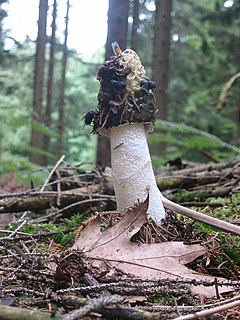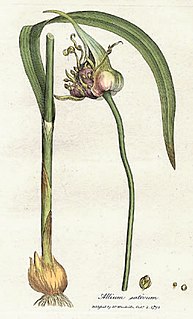
Primula is a genus of mainly herbaceous flowering plants in the family Primulaceae. They include the familiar wildflower of banks and verges, the primrose. Other common species are P. auricula (auricula), P. veris (cowslip) and P. elatior (oxlip). These species and many others are valued for their ornamental flowers. They have been extensively cultivated and hybridised - in the case of the primrose, for many hundreds of years. Primula are native to the temperate northern hemisphere, south into tropical mountains in Ethiopia, Indonesia and New Guinea, and in temperate southern South America. Almost half of the known species are from the Himalayas.

Phallaceae is a family of fungi, commonly known as stinkhorn mushrooms, within the order Phallales. Stinkhorns have a worldwide distribution, but are especially prevalent in tropical regions. They are known for their foul-smelling, sticky spore masses, or gleba, borne on the end of a stalk called the receptaculum. The characteristic fruiting-body structure, a single, unbranched receptaculum with an externally attached gleba on the upper part, distinguishes the Phallaceae from other families in the Phalalles. The spore mass typically smells of carrion or dung, and attracts flies, beetles and other insects to help disperse the spores. Although there is great diversity in body structure shape among the various genera, all species in the Phallaceae begin their development as oval or round structures known as "eggs". According to a 2008 estimate, the family contains 21 genera and 77 species.

The Trionychidae are a taxonomic family of a number of turtle genera, commonly known as softshell turtles. The family was erected by Leopold Fitzinger in 1826. Softshells include some of the world's largest freshwater turtles, though many can adapt to living in highly brackish areas. Members of this family occur in Africa, Asia, and North America. Most species have traditionally been included in the genus Trionyx, but the vast majority have since been moved to other genera. Among these are the North American Apalone softshells that were placed in Trionyx until 1987.

Homo is the genus that emerged in the genus Australopithecus that encompasses the extant species Homo sapiens, plus several extinct species classified as either ancestral to or closely related to modern humans, most notably Homo erectus and Homo neanderthalensis. The genus emerged with the appearance of Homo habilis just over 2 million years ago. Homo, together with the genus Paranthropus, is probably sister to Australopithecus africanus, which itself had previously split from the lineage of Pan, the chimpanzees.

The Chinese alligator, also known as the Yangtze alligator, China alligator, or historically the muddy dragon, is a crocodilian endemic to China. It and the American alligator are the only living species in the genus Alligator of the family Alligatoridae. Dark gray or black in color with a fully armored body, the Chinese alligator grows to 1.5–2.1 metres (5–7 ft) in length and weighs 36–45 kilograms (80–100 lb) as an adult. It brumates in burrows in winter and is nocturnal in summer. Mating occurs in early summer, with females most commonly producing 20–30 eggs, which are smaller than those of any other crocodilian. The species is an opportunistic feeder, primarily eating fish and invertebrates. A vocal species, adults bellow during the mating season and young vocalize to communicate with their parents and other juveniles. Captive specimens have reached age 70, and wild specimens can live to over 50.

Neurotrichus is a genus of shrew-like moles. It is classified, together with the fossil genus Quyania, in the tribe Neurotrichini of the subfamily Talpinae. The only living species is the American shrew-mole (N. gibbsii) of the northwestern United States and British Columbia. A fossil species, Neurotrichus columbianus from the Hemphillian of Oregon, was placed in the genus in 1968, but this animal is now thought to be more closely related to the Chinese fossil genus Yanshuella.

Morinda is a genus of flowering plants in the madder family, Rubiaceae. The generic name is derived from the Latin words morus "mulberry", from the appearance of the fruits, and indica, meaning "of India".

Cathayornis is a genus of enantiornithean birds from the Jiufotang Formation of Liaoning, People's Republic of China. It is known definitively from only one species, Cathayornis yandica, one of the first Enantiornithes found in China. Several additional species were once incorrectly classified as Cathayornis, and have since been reclassified or regarded as nomina dubia.

Similicaudipteryx, meaning "similar to Caudipteryx", is a genus of theropod dinosaur of the family Caudipteridae.

Pelodiscus is a genus of turtles in the family Trionychidae, the softshells. Based on genetic and morphological analysis there are five valid species. They are native to Eastern Asia, ranging from the Amur region, through China, Korea and Japan, to Vietnam.
Eocypraeidae is a small family of large sea snails, marine gastropod molluscs in the superfamily Cypraeoidea, the cowries and cowry allies.
Sinotympana is an Asian genus of cicadas in the tribe Dundubiini.

Niveria is a genus of small sea snails, marine gastropod molluscs in the family Triviidae, the false cowries or trivias.
Qiliania is an extinct genus of early bird from the lower Cretaceous about 120 million years ago. It is an enantiornithean which lived in what is now Gansu Province, north-western China. It is known from two incomplete, semi-articulated and three-dimensionally preserved skeletons, which were found in the Xiagou Formation of the Changma Basin. It was first named by Shu-An Ji, Jessie Atterholt, Jingmai O'Connor, Matthew Lamanna, Jerry Harrs, Li Da-Qing, You Hai-Lu and Peter Dodson in 2011 and the type species is Qiliania graffini. The species was named for Greg Graffin, a paleontologist and member of the punk rock group Bad Religion, at the suggestion of coauthor Jingmai O'Connor, a longtime fan of the band.
Pseudopusula is a genus of small sea snails, marine gastropod mollusks in the family Triviidae, the false cowries or trivias.

This timeline of hadrosaur research is a chronological listing of events in the history of paleontology focused on the hadrosauroids, a group of herbivorous ornithopod dinosaurs popularly known as the duck-billed dinosaurs. Scientific research on hadrosaurs began in the 1850s, when Joseph Leidy described the genera Thespesius and Trachodon based on scrappy fossils discovered in the western United States. Just two years later he published a description of the much better-preserved remains of an animal from New Jersey that he named Hadrosaurus.

Allium is a genus of monocotyledonous flowering plants that includes hundreds of species, including the cultivated onion, garlic, scallion, shallot, leek, and chives. The generic name Allium is the Latin word for garlic, and the type species for the genus is Allium sativum which means "cultivated garlic".

This timeline of pterosaur research is a chronologically ordered list of important fossil discoveries, controversies of interpretation, and taxonomic revisions of pterosaurs, the famed flying reptiles of the Mesozoic era. Although pterosaurs went extinct millions of years before humans evolved, humans have coexisted with pterosaur fossils for millennia. Before the development of paleontology as a formal science, these remains would have been interpreted through a mythological lens. Myths about thunderbirds told by the Native Americans of the modern Western United States may have been influenced by observations of Pteranodon fossils. These thunderbirds were said to have warred with water monsters, which agrees well with the co-occurrence of Pteranodon and the ancient marine reptiles of the seaway over which it flew.
Luopterus is an extinct genus of anurognathid pterosaur containing only the holotype species L. mutoudengensis that is known from the Middle Jurassic Tiaojishan Formation of Qinglong, northern Hebei Province, China. It was originally named as a species of Dendrorhynchoides in 2012 but it was moved to the genus Luopterus in 2020. Luopterus was originally thought to be from the Early Cretaceous, with a wingspan that is about 40 centimeters (16 in), making it one of the smallest known pterosaurs.
Desmotes is a monotypic genus of flowering plants belonging to the family Rutaceae. The only species is Desmotes incomparabilis.













